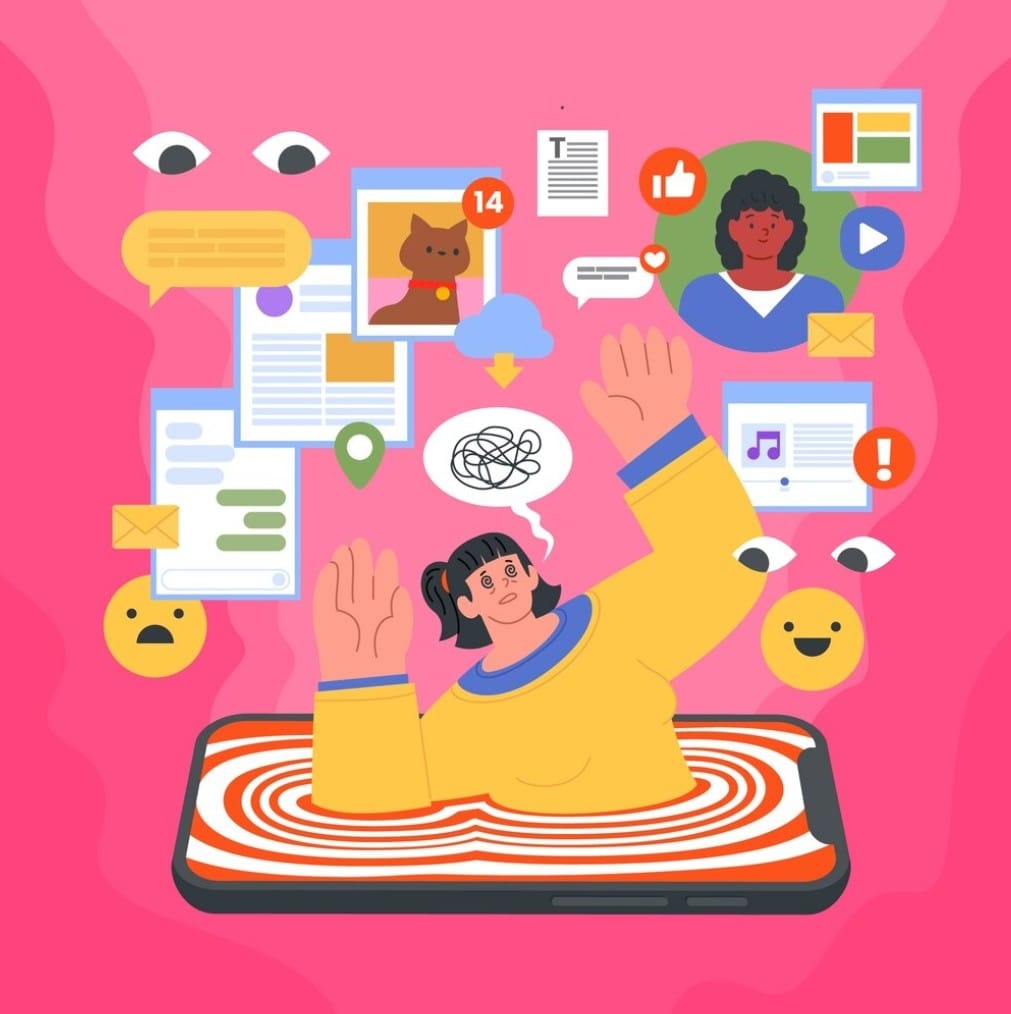Societal influence on an individual’s self-image is a complex process involving cultural norms, media portrayal, peer expectations, and societal standards of beauty and success. Since childhood, individuals are exposed to these messages, which significantly impact their self-esteem, self-worth, and overall self-image. Media plays a chief role in shaping societal norms and ideals, emphasizing certain body types, lifestyles, and beauty standards. Peer groups also influence a person’s self-image, driving people to conform to their peer groups’ expectations, such as adopting certain fashion trends or adhering to specific behaviors. Cultural values and traditions further shape self-image by influencing the perception of success, happiness, and fulfilment. Societal expectations regarding career choices, relationships, and personal achievements can lead individuals to internalize these norms and evaluate their self-worth based on societal benchmarks. The impact of societal influence on self-image varies across individuals and cultures, with some resisting societal pressures and cultivating a strong sense of individuality and others struggling with feelings of inadequacy and self-doubt. Recognizing and critically evaluating these societal influences is crucial for developing a more authentic and resilient self-image grounded in personal values and a realistic understanding of their unique identity.

EFFECT OF CULTURAL STANDARDS:
Cultural standards significantly influence an individual’s self-image, shaping their perception of beauty, success, behavior and societal roles. These standards can lead to body dissatisfaction and body dysmorphic disorders. They also influence self-worth and accomplishment, potentially causing feelings of inadequacy if personal achievements do not align with societal standards. Cultural standards also affect interpersonal relationships and behavior with individuals feeling pressured to conform to social norms, stifling authentic self-expression. Fear of social ostracism or rejection can lead to conformity, while those who deviate may experience isolation and marginalization, affecting self-esteem and self-image. The influence of cultural standards is dynamic and varied across cultures and individuals. Some may embrace and internalize cultural ideals, while others may resist or challenge these norms. Recognizing the impact of cultural standards is crucial for fostering a healthy self-image, allowing individuals to critically evaluate societal expectations, embrace authenticity, and develop a sense of self-worth independent of external pressures. Understanding and navigating the relationship between cultural standards and self-image is essential for promoting mental well-being and cultivating a resilient sense of identity.
THE INFLUENCE OF MEDIA:
Cultural standards significantly influence an individual’s self-image, shaping their perception of beauty, success, behavior and societal roles. These standards can lead to body dissatisfaction and body dysmorphic disorders. They also influence body image perceptions and contribute to a culture of comparison. Media portrayal of success can also affect self-image by promoting certain lifestyles and achievements as markers of accomplishment, creating a sense of inadequacy for those who do not meet these standards. It can lead to feelings of failure or discontent, impacting self-esteem and overall well-being. Media also influences behavioral norms, shaping expectations around relationships, communication, and social interactions. Characters in movies and television often depict idealized versions of relationships, contributing to unrealistic expectations. Social media platforms can amplify comparison and contribute to feelings of inadequacy. Recognizing the media’s impact on self-image is crucial for cultivating a healthy sense of identity. Developing media literacy skills can help individuals critically evaluate and question images and messages, fostering a more realistic understanding of beauty, success, and personal worth.
PEER PRESSURE:
Peer pressure significantly impacts a person’s self-image as they seek social acceptance and validation from their peers. This conformity can have profound effects on self-image, shaping how individuals perceive their worth and identity within the social context. Adolescence is affected by peer pressure, as conformity may lead to adopting attitudes or styles that align with popular trends, potentially sacrificing their unique identity. Positive peer influence can bolster self-esteem and contribute to a positive self-image, fostering a sense of belonging and acceptance. Conversely, negative peer pressure can have detrimental effects on self-image, as fear of judgment or exclusion can lead to activities contrary to one’s values or well-being. To resist negative peer pressure, individuals need a strong self-awareness and self-worth. Striking a balance between social connections and authenticity is crucial for maintaining a positive self-image. Developing a healthy self-image in peer relationships involves striking a balance between social connections and maintaining authenticity, allowing individuals to navigate peer influence while staying true to their values and beliefs.
EFFECT OF SOCIAL COMPARISONS ON A PERSON’S SELF-IMAGE:
Social comparisons significantly influence a person’s self-image, affecting their perception of themselves against others. Healthy social comparisons, where individuals perceive themselves as superior, can boost self-esteem and contribute to a positive self-image.
However, pessimistic social comparisons, where individuals perceive themselves as falling short, can have detrimental effects on self-image. Social media can exacerbate these comparisons, as individuals often present idealized versions of their lives. The impact of social comparisons may vary depending on individual factors, with those with lower self-esteem more susceptible to harmful effects. To mitigate the negative impact of social comparisons on self-image, individuals must cultivate self-awareness and self-compassion. Recognizing one’s unique strengths, setting realistic goals, and appreciating personal progress can help build a more resilient self-image. Fostering a mindset that values individuality and embraces diversity can contribute to a healthier perspective on social comparisons, emphasizing personal growth and authenticity over external benchmarks.
GENDER EXPECTATIONS:
Gender expectations significantly influence a person’s self-image, shaping their perception and definition of themselves with societal norms. From a young age, individuals are exposed to the to the cultural, social, and familial Social comparisons significantly influence a person’s self-image, affecting their perception of themselves against others. Healthy social comparisons, where individuals perceive themselves as superior, can boost self-esteem and contribute to a positive self-image. expectations that dictate how they should behave, express themselves, and fulfil roles based on their gender. Traditional gender norms prescribe specific standards of beauty and behavior for men and women, with women often subjected to societal pressures to conform to ideals of physical attractiveness. Men face physical strength, emotional stoicism, and career success expectations. The impact of gender expectations on self-image can be profound, leading to constant evaluation of appearance, behaviors, and achievements about gender-specific standards. Non-conformity to these expectations can result in feelings of inadequacy, judgment, or social exclusion. Gender expectations influence various life choices, career decisions, and interpersonal relationships. Challenging or resisting gender expectations can be complex, as breaking free from traditional norms may lead to societal scrutiny or backlash. Promoting gender equality, diversity, and inclusivity can contribute to a more inclusive and empowering societal framework, allowing individuals to define their self-image beyond restrictive gender expectations. Encouraging conversations around breaking gender stereotypes, celebrating diverse expressions of gender identity, and fostering an environment that embraces individual authenticity can contribute to a healthier and more inclusive self-image for everyone.
ECONOMIC EXPECTATIONS:
Economic factors significantly influence a person’s self-image, affecting their perception of financial success, social status, and overall well-being. Economic stability and success can lead to higher self-esteem, while social comparisons can lead to feelings of inadequacy and stress. Access to opportunities is also influenced by economic circumstances, with individuals from economically disadvantaged backgrounds facing systemic barriers that limit their sense of agency and self-efficacy. Consumer culture is influenced by economic factors, where the acquisition of material possessions is connected to societal notions of success and happiness. The pressure to conform to consumerist ideals can lead individuals to tie their self-worth to material possessions, contributing to a superficial and externally driven self-image. Social mobility is influenced by economic factors, with upward or downward mobility affecting aspirations. Job satisfaction and identity are also influenced by economic factors. Fulfilling and well-compensated jobs can provide a sense of identity and purpose, and dissatisfaction with work or economic precarity can lead to feelings of unfulfillment and a negative self-perception. Understanding the intersection of economic factors and self-image is crucial for promoting well-being. Fostering economic opportunities, advocating for social equality, and promoting financial literacy can contribute to a more inclusive societal framework, allowing individuals to develop a healthier and more resilient self-image regardless of economic circumstances.
CULTURAL DIVERSITY:
Cultural diversity significantly influences a person’s self-image, shaping their perception of themselves within their cultural identity and societal tapestry. This relationship is dynamic, and influenced by cultural values, traditions, experiences, and interactions with diverse communities. Cultural diversity can lead to a positive self-image by providing individuals with a rich tapestry of cultural backgrounds, each contributing unique elements to their identity. Exposure to diverse cultures broadens perspectives and challenges stereotypes, enhancing self-esteem and promoting open-mindedness. Language and communication skills are crucial aspects of cultural diversity, as proficiency in various languages and communication styles contributes to adaptability and cultural competence. Cultural norms and expectations are introduced, leading to a more nuanced understanding of one’s identity. Intersectionality with other aspects of identity, such as race, ethnicity, gender, and sexuality, allows individuals to recognize the complexity of their identity and foster a more inclusive and authentic self-image. Cultural celebrations and events instill a sense of pride and positive self-image, encouraging individuals to appreciate and take pride in their heritage. Overcoming challenges related to cultural biases, discrimination, or acculturation can contribute to the development of resilience and a strong sense of self. In summary, cultural diversity shapes a person’s self-image by providing a multifaceted lens through which they view themselves and their place in the world. Embracing cultural diversity can lead to a more enriched, inclusive, and authentic self-image, fostering a sense of pride, belonging, and interconnectedness within the broader global community.

EFFECTS OF SOCIAL MEDIA:
Social media has a profound impact on a person’s self-image, both positively and negatively. It amplifies societal beauty standards, encourages comparisons, and can affect self-esteem. Idealized representations of people’s lives, often curated, can create unrealistic expectations and feelings of inadequacy when individuals compare themselves to these portrayals. The comparison culture on social media can lead to feelings of inferiority, lower self-esteem, and dissatisfaction with one’s life. Filters and photo editing tools on social media can distort reality, creating an unrealistic standard of beauty. It can lead to body dissatisfaction and a skewed perception of one’s physical appearance. The wanting of likes and validation on social media can become a significant source of self-worth, leading to reliance on external validation for a positive self-image. Fear of missing out (FOMO) can also affect self-esteem and contentment. Social media often portrays others’ highlight reels, leading to questions about the adequacy of one’s life and activities. Cyberbullying and negative feedback can also have a detrimental impact on self-image, leading to feelings of shame, embarrassment, or inadequacy. Lastly, social media can create pressure to conform to trends, lifestyles, or beauty standards. The desire to fit in and gain social acceptance may lead individuals to adopt behaviors or styles that align with popular trends, potentially compromising their authentic self-expression. To understand the negative effects, it is essential to cultivate media literacy, set healthy boundaries, and foster a strong sense of self-awareness. Being mindful of the curated nature of social media content, focusing on real-life experiences, and prioritizing authentic connections over virtual validation can contribute to a more positive and resilient self-image in the digital age.
Self-image is shaped by a complex interplay of societal, cultural, economic, media, and social factors. These influences contribute to the formation of an individual’s self-perception, with understanding these dynamics crucial for cultivating a healthy and authentic sense of self. Societal expectations, perpetuated through media and cultural norms, can create unrealistic beauty standards, success, and behavior, leading to feelings of inadequacy and a constant quest for external validation. Peer pressure, rooted in the human desire for social acceptance, can compromise individual authenticity. Economic factors impact financial stability, access to opportunities, and perceptions of success. Cultural diversity enriches self-image by providing a mosaic of identities and experiences, fostering pride, belonging, and resilience. Social media presents challenges, including comparison culture, external validation, and exposure to idealized representations. Navigating these influences requires self-awareness, critical thinking, and a commitment to authenticity. Cultivating resilience in the face of societal pressures involves challenging unrealistic standards, embracing cultural diversity, and promoting positive social interactions. Media literacy is essential for deciphering online content and engaging with social media.
Written by – Diya Pillai | Edited by Nirjara Poptani



